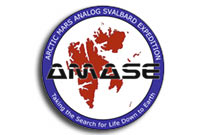NASA AMASE 2008: Welcome to Arctic Mars Analog Svalbard Expedition (AMASE)

August 4, 2008 / Written by: Andrew Steele
What is AMASE.
Since 2003 the Arctic Mars Analogue Svalbard Expedition has been traveling to field sites on Svalbard to test the protocols, procedures and equipment needed to detect traces of organic chemistry and perhaps life on Mars. The AMASE crew over the years has consisted of over a hundred scientists and engineers from institutions around the world. AMASE is run by Hans Amundsen (Expedition Leader EPX Norway), Andrew Steele (Science Leader – Carnegie Institution of Washington), Marilyn Fogel (Management team – Carnegie Institution of Washington), Pan Conrad (Management team – JPL) and Lianne Benning (Management team – University of Leeds, UK). Currently both NASA, (through an Astrobiology Technology for Exploring Planets (ASTEP) grant A Steele, PI) and the European Space Agency (H Amundsen – PI) are testing instruments for the 2009 NASA Mars Science Laboratory mission and the 2013 ESA ExoMars mission.
Current instruments onboard AMASE 08 include:
- Chemin – Mineralogy identification – MSL
- SAM – Organic compound analyzer – MSL
- WISDOM – Ground penetrating radar – ExoMars
- PanCam – Stereo camera – ExoMars
- MIMA – Infrared spectrometer – ExoMars
- Raman LIBS – spectrometers – ExoMars
- MASSE – Protein Microarray instrument – being developed for Exomars as part of the Life Marker Chip effort.
- LOCAD, PTS – currently flying onboard the international space station.
This ESA link has descriptions of instruments for ExoMars.
These instruments are backed up by a suite of commercial off the shelf instruments that includes a fully equipped field molecular biology laboratory. Furthermore, currently we are testing a “cliffbot” rover system from NASA JPL. This Rover can navigate steep cliffs using anchor points and then deploy a robotic arm to image and collect samples (Link). Currently we are beginning to use this rover concept for the collection of samples for a putative Mars sample return mission.
The philosophy of testing is too analyze samples of Mars relevance at the field site using field deployable models of space flight instruments. The performance of these is measured against other field deployable instruments and against laboratory based instruments upon the return of the samples from the field. Furthermore AMASE drills the teams in what it is like to conduct remote operations on Mars using models developed by Steve Squyres (Cornell University) and based on experiences of the teams involved in the the Mars Exploration Rovers.
With a unique combination of volcanoes, hot springs and permafrost, the Bockfjord Volcanic Complex (BVC) on the Arctic islands of Svalbard is the only place on Earth with carbonate deposits identical to carbonates in the Martian meteorite ALH84001. As such, it provides a unique opportunity to study the interaction between water, rocks and primitive life forms in a Mars-like environment and is an ideal testing ground for instruments under development for future “Search for Life” missions to Mars. AMASE research topics also centre on the formation and weathering of carbonate deposits in various BVC localities and include cryogenic carbonate deposits, cryptoendolithic communities, glacial ice, sedimentary deposits and blue ice vents in subglacial volcanoes and associated microbial activity, bio-geo interactions and organic chemistry.
AMASE could not undertake the exciting projects and field work without the support of both NASA and ESA. Furthermore, there is significant help and logistics support from the Norwegian Space Agency, Norwegian Polar Institute and the crew of the RV Lance, the University centre on Svalbard and the Governor of Svalbard.









